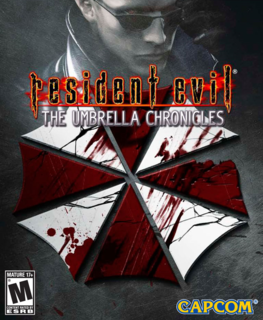Horrific?
Because that is, in many ways, what Umbrella Chronicles does. UC allows you to revisit locations from previous resi games, playing through them in a brand new way, and seeing snippets of storyline and plot that, up until now, have been shrouded in mystery. Its squarely aimed at long-term fans of the series, then, as much of the nuances of its story exposition will be meaningless to those who have not played the games in question. For those gamers, UC offers a good deal- giving you the chance to play as characters who featured in the games in question but were not playable, or giving you extra parts of storyline omitted from the series and designed to fill in gaps in the plot. From the original Resident Evil (or rather, its Gamecube remake) you can play a section as STARS Captain Albert Wesker, to see his side of the story and what happens to him. It's a novel idea, and one that will likely attract a lot of fans back to the series, to play it in a completely different way.
And what better way to make use of the Wii's motion sensitive capabilities than.... a lightgun game?
That's right. UC harks back to the good ol' days of the arcade, when Time Crisis and House of the Dead and all those other on-rails shooters were all the rage and you couldn't step down an aisle of cabinets without being poked by a protruding firearm. And in all fairness to UC, it does the formula well. The Wiimote is easily responsive enough to work as a lightgun, although its diminutive size might feel a little odd to those used to the arcades or Namco's GunCon. Controls are simple enough, then- point at the screen, use the trigger to fire, shake the wiimote quickly from side to side to reload (an RSI-inducing action, to be sure) and use the D-pad to switch to other weapons. The d-pad is actually the only control niggle with the game; those of you with larger hands might find it a bit awkward to tap the buttons to change weapon whilst simultaneously reloading and aiming at a zombie. Everything else is as responsive and effortless as it should be. You can even perform knife attacks by holding the B button and swishing the Wiimote from side to side.
In fact, viewed as a lightgun game, RE:UC offers a great deal. It's a lengthy experience to be sure, lasting for some 6-7 hours on a normal play through, and there's plenty to go back and unlock, including various reports and files, additional weapons, and extra characters and modes. By any other standard, it's a little shallow, but it offers more depth than many of its genre. It's also good fun to play; the levels are varied enough to maintain the interest throughout, and the various weapons and challenges the game throws at you serve to spice up the action a little.
However, it's when viewed as a Resident Evil game that UC falls down a little. Whilst the chance to-revisit, in first person, some famous locales from the series is exciting in theory, in practise is doesn't play out so well. The first section- In Resident Evil Remake's Mansion – is exceptional, as are the areas from Resident Evil Zero- for both sections Capcom has used the original models used for the fmv backdrops but integrated them into the game. The Resident Evil 2 and 3 sections are remarkably poor in comparison, however, as they use areas taken from the Outbreak games for the PS2. Not only are these rather lower quality and bland-looking, but they also miss out many of the locations from the games themselves- barely any of the Resident Evil 2 section, for example, takes place in the Police Station.
The game isn't beautiful at the best of times, as it simply recycles character models from older games and doesn't attempt to spruce them up with any new bells or whistles, though there's still visceral satisfaction to be gained from blasting zombies heads off so that they splatter all over the place. The framerate also takes a couple of unfortunate nose-dives, usually when the game tries to employ lighting effects that look outdated at best. Still, there's plenty of interaction in the environments, and loads of objects and parts of scenery that can be destroyed, which adds a nice level of detail.
The music and sounds are the same recycled tunes you've heard before in Res games, although some of the music tracks have been rather poorly remixed to suit UC's faster tempo, when in fact the original, spooky soundtrack might have added another level of tension to the game. The voice acting is equally uninspired, as few of the more established cast members return to lend voices to the characters. The worst culprits are, oddly, Resident Evil 3's Nemesis- who rather camply mutters 'Stars?' every now and again, and villain Albert Wesker, who makes mention of a terrible incident involving zombays, whatever those are. Resi's voice acting has never been top notch, (though 4 tries hard to shake the trend) but at times, UC feels more like one of the poor PSone Survivor games.
Still, when all's said and done, RE:UC is a blast to play, and that's the most important thing. It's a must have for Resi fans, just for some of the story content, although some of this does contradict previously established plot elements. But it's particularly enjoyable to play through with a friend, and it does offer the great on-rails shooter gameplay that Time Crisis and Virtua Cop popularised, and feels like a refined, more story-driven House of the Dead at times. In short, it's fun. But don't expect it to last too long, or hold your attention long after you've completed it.

